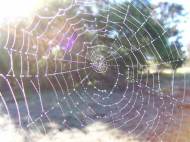Spider web inspires new medical materials
 We already published several articles about studies where spiders served as inspiration for biomimicry and analysis, but the new study by the researchers from the University of Akron developed the new biocompatible synthetic material similar to a specific kind of silk spun by orb spiders. The material could be used as new kinds of medical sutures that can be embedded with medication.
We already published several articles about studies where spiders served as inspiration for biomimicry and analysis, but the new study by the researchers from the University of Akron developed the new biocompatible synthetic material similar to a specific kind of silk spun by orb spiders. The material could be used as new kinds of medical sutures that can be embedded with medication.
Spider webs were used several hundred years ago as gauze pads to stop an injured person’s bleeding. This occurs because spider webs are rich in vitamin K, which can be effective in clotting blood. Instead focusing on that fact, the researchers were intrigued by the specific web design and the glue droplets which look like beads on a string in a circular web of orb spiders – a shape they refer to it as BOAS structure.
“We have been very interested in architecture of adhesives produced by spiders and were very intrigued to understand why spiders use the BOAS structure”, said Vasav Sahni, UA polymer science graduate student and lead author of the article published in Langmuir.
Sahni and research team members Dr. Ali Dhinojwala, chair of the Department of Polymer Science and Maurice Morton Professor of Polymer Science, and Disha Labhasetwar, an NSF-REU student with the Department of Polymer Science designed and fabricated a specialized piece of equipment used to create the threads. They managed to create an artificial BOAS structure by applying techniques similar to ones used by spiders when they spin silk.
“We used fluid mechanics concepts to vary the size and spacing of the glue beads and mimicked the spider silk threads by using commercially available materials, such as nylon”, said Sahni.
Instead placing individual glue drops on a string, the new method uses waves to form the glue, which morphs into beads in a uniform distribution along the threads. The beads create larger contact areas and also release energy when peeled. The replication of this design can potentially be used as strong and flexible sutures that contain medication embedded in these bead-like structures.
The next step is to apply for funding to speed the commercialization process to create medical materials that can help heal injured tendons or tissue. Dhinojwala, Sahni and their research colleagues developed the biocompatible thread to address one of the needs identified in a pilot program with the Austin BioInnovation Institute in Akron (ABIA). The researchers plan to apply for a $25,000 ABIA grant to fund development of a prototype and hope to see it commercialized locally.
Aside being used to produce medical materials, the University of Akron researchers pointed out that their simple and scalable technique allows for rapid and large-scale fabrication of the new adhesives as well.
For more information, read the article published in the American Chemical Society journal Langmuir: “Spider Silk Inspired Functional Microthreads”.









Mysteries of nature revealed and adopted.
Dr.A.Jagadeesh Nellore(AP),India
E-mail: anumakonda.jagadeesh@gmail.com